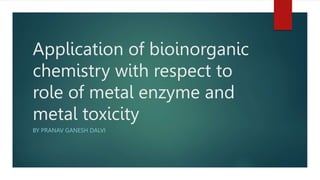
Application of bioinorganic chemistry.pptx
- 1. Application of bioinorganic chemistry with respect to role of metal enzyme and metal toxicity BY PRANAV GANESH DALVI
- 2. METALLOENZYME Enzymes are catalyst for biological system The biocatalyst has the main frame-work built of protein but in metalloenzyme activity depends on the presence of desired metal ion Thus metalloenzyme has two structural components : the protein portion described as apoenzyme and a small non-protein prosthetic group which may be a simple metal ion or a complexed metal ion
- 3. CARBONIC ANHYDRASE ENZYME Structure : Zn+2 (d10) Tetrahedral geometry Three valency is filled with nitrogen of histidine amino acid and 4th valency is satisfied with water
- 4. CARBONIC ANHYDRASE ENZYME Functions : In 1939,it was established that it is the Zn+2 containing metalloenzyme known as carbonic anhydrase (CA) responsible for catalysing the reversible hydration of CO2 in blood CO2 is the starting material in photosynthesis and it is the end product of respiration Thus the hydration of CO2 and dehydration of H2CO3 is important in animals, plants and several bacteria
- 5. CARBONIC ANHYDRASE ENZYME MECHANISM :
- 6. QUESTIONS Q. THE METAL ION OF THE ENZYME INVOLVED IN HYDRATION OF CO2 IS A. Cu2+ B. Fe2+ C. Mg2+ D. Zn2+
- 7. CARBOXY PEPTIDASE ENZYME Structure : Zn2+(d10) tetrahedral geometry 2 valency is filled with nitrogen of histidine amino acid and 1 with glutamic acid amino acid and the 4th valency was satisfied with water
- 8. CARBOXY PEPTIDASE ENZYME Functions : It catalyses the hydrolysis of carboxyl terminal peptide bonds (also known as exopeptidase enzyme ) The Zn2+ containing enzymes are released from their inactive precursors or zymogens (i.e . Procarboxypeptidase) in the pancreas for the digestion of proteins . This pancreatic enzyme is very much specific to hydrolyse the terminal peptide linkage at carboxyl end. it shows a marked preference towards expected linkages in which the side chain of the terminal residue contain some aromatic moiety or branched aliphatic chain with L-configuration denoted by (θ)
- 9. LIVER ALCOHOL DEHYDROGENASE ENZYME (LADH) Structure : Zn2+ (d10) Tetrahedral geometry 2 valency is filled with sulphur of cystine amino acid , 1 with nitrogen of histidine amino acid and 4th valency was satisfied with water
- 10. LIVER ALCOHOL DEHYDROGENASE ENZYME (LADH) Functions : LADH catalyses the reversible dehydrogenation of primary and secondary alcohols to aldehyde and ketones respectively the reactions use NAD+ /NADH system. The overall reaction is given below involves hydride transfer followed by loss of proton
- 11. QUESTION Why does nature choose Zn+2 metal ion as the active site for so many hydrolytic enzyme ? 1. Zn metal ion only exist in +2 oxidation state 2. It is redox inactive 3. It only has tetrahedral geometry 4. It is a borderline hard acid 5. Zn+2 is a good lewis acid
- 12. PEROXIDASE ENZYME Structure : Heme containing enzyme (Iron +porphyrin group) Fe+3 octahedral geometry high spin complex the axial valencies are filled with nitrogen of histidine and water
- 13. PEROXIDASE ENXYME Functions: Peroxidase catalyses the oxidation of any compound in presence of H2O2 (peroxide)
- 14. CATALASE ENZYME Structure : It is a tetramer of peroxidase enzyme Heme containing enzyme Octahedral geometry High spin complex
- 15. CATALASE ENZYME Functions: DECOMPOSITION OF H2O2
- 16. CYTOCHROME P450 Structure: Heme containing enzyme Octahedral geometry Low spin complex Axial valencies are filled with sulphur of cystine and water
- 18. CYTOCHROME C OXIDASE ENZYME Structure : Cytochrome c oxidase enzyme consists of four redox centres i.e. CuA , CuB , Heme a and heme a3
- 19. CYTOCHROME C OXIDASE Functions : The electrons from cyt c oxidase are transferred to O2 to reduce it to H2O
- 20. XANTHINE OXIDASE ENZYME Structure : It consists of 1 Mo , 2 Fe2S2 (Ferrodoxin) and one FAD unit
- 21. XANTHINE OXIDASE ENZYME Function : It catalyses the oxidation of xanthine to uric acid
- 22. ALDEHYDE OXIDASE ENZYME Structure : It consists of 2 Mo ,4 Fe2S2 ,2 FAD UNIT
- 23. ALDEHYDE OXIDASE ENZYME Functions : It catalyses the oxidation of aldehyde to carboxylic acid
- 25. Zn-Cu SOD(SUPEROXIDE DISMUTASE) Structure As the name suggests it has two copper and zinc site zinc and copper both has oxidation state +2 copper +2 is having square planar geometry Zinc +2 it is in a tetrahedral geometry In fact copper +2 is equatorially coordinated to 4 histidyl imidazole( his- 46,his-118, his-44 and his – 61) and a water molecule remains weekly bound to one axial position to give up highly distorted square pyramidal geometry the zinc +2 center is coordinated to three histidyl Imidazole( histidine 78 ,histidine 69 and bridging histidine 61) and the carboxylate group of aspartyl residue( Asp- 81) to obtain the tetrahedral geometry
- 27. Zn-Cu SOD(SUPEROXIDE DISMUTASE) Functions : In the enzymatic reaction O2 - reaches the bottom of protein channel where Cu+2 resides and O2 reduces Cu+2 to Cu+1 producing O2. as soon as the Cu+1 center is produced the bridging imidazolate group histidine 61 is dislodged from the copper center but remains coordinated with zinc +2 and water protonates the partially dislodged imidazole group ( as imidazole moiety is highly basic). at the next step another O2 - anion approaches and oxidises Cu+1 to Cu+2 and O2 -is reduced to HO2 - which is further protonated by water to give H2O2. thus the Cu - centre is reversibly reduced and oxidised by successive encounter with superoxide giving rise to O2 and H2O2 as the respective steps
- 28. Vitamin B12